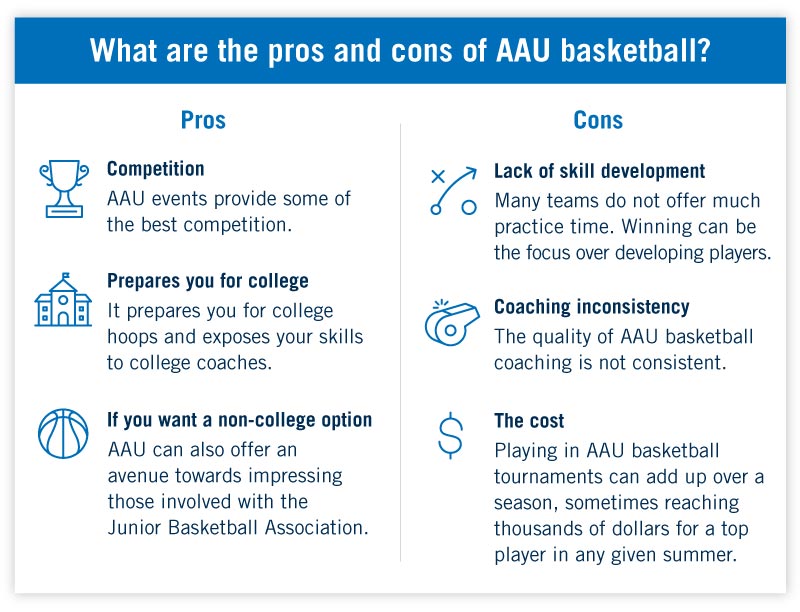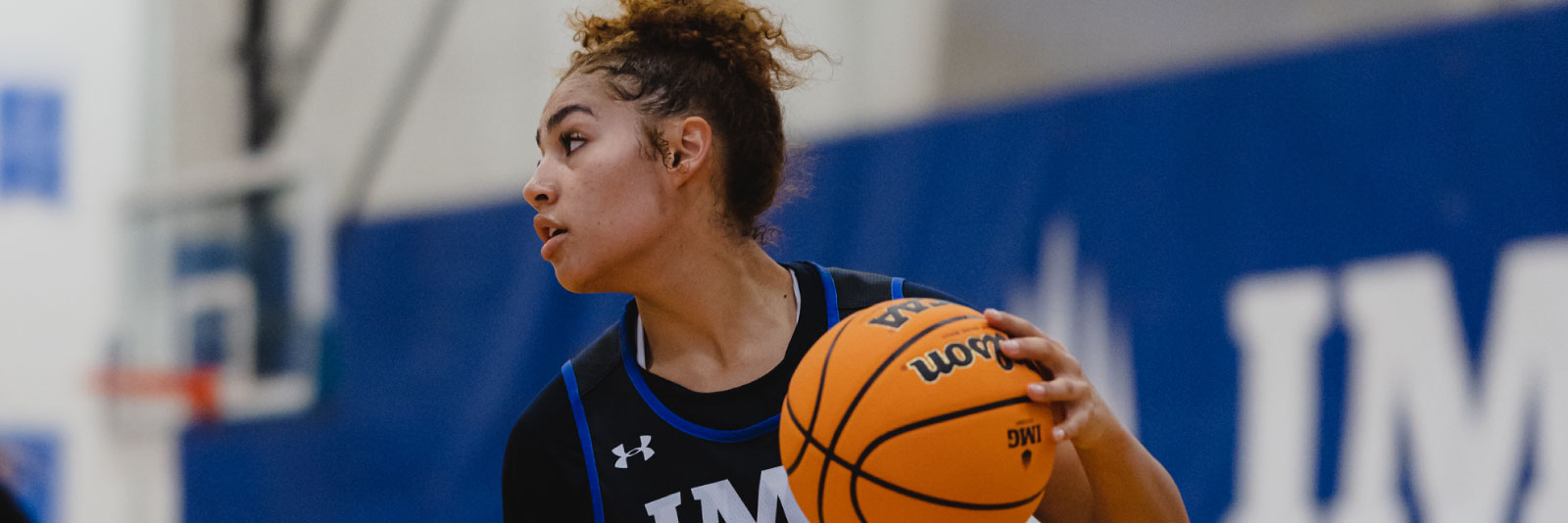AAU girls’ basketball has given many girls and young women a chance to grow athletically. They learn to be fierce competitors and leaders on and off the court. But if you’re new to the AAU, you may have some questions. Below we’ll go over everything there is to know about AAU girls’ basketball.
What is AAU girls’ basketball?
AAU stands for Amateur Athletic Union. It’s a non-profit volunteer organization with clubs spread across the United States. AAU girls’ basketball is one of the 40+ sports under its umbrella.
AAU girls’ basketball is one of its most popular sports. It has numerous age groups of players ranging from second to 12th grade. They learn skills they can take back to their high school teams and, for many of them, to college ball.
But that’s not all the AAU has to offer. Those who sign up for the AAU also experience the benefits of the AAU’s mission statement. AAU girls’ basketball participants should be able to experience physical, mental, and character development and be taught good sportsmanship and citizenship. Of course, the sport is crucial to those participating in AAU girls’ basketball tournaments, but so are these other values.
One of the most significant benefits of taking part in AAU girls’ basketball is finding teams and competitions that provide challenging environments with quality learning opportunities, but not so hard that they’re overwhelming. In other words, you are good enough to participate in AAU girls’ basketball tryouts regardless of your skills; what needs to be determined is finding the best fit for you and the team(s) that you’re trying out for.
AAU history
AAU has had a storied history, which dates to 1888. It was founded on January 21 of that year at the New York Athletic Club and has overseen various sports programs since then. It was the primary governing body for sports such as track and field at times, developing athletes for the Olympics. However, since the Olympic Sports Act of 1978 passed, it has transitioned its focus to young athletes, primarily high school age and younger.
AAU girls’ basketball has been a part of the organization since 1923. The first AAU-held basketball tournament for female athletes was held in 1926. Now, thousands of AAU girls’ basketball teams are spread across 56 districts, which frequently have the same borders as states, but several exceptions exist. For example, Alabama and Tennessee comprise the Southeastern district, Utah’s community includes northeastern Nevada, and Texas is divided into five separate districts, one of which also consists of all of New Mexico.
AAU girls’ basketball information
Your local AAU organization website should have all the detailed information you need, like:
- AAU girls’ basketball tournaments
- AAU girls’ basketball rankings
- AAU girls’ basketball schedules
- AAU girls’ basketball teams
- AAU girls’ basketball camps.
For example, AAU Florida offers an event look-up page on its website. Some of these local organizations have also, from time to time, posted AAU girls’ basketball rankings of teams located within that area.
Events at ESPN Wide World of Sports in Lake Buena Vista, Fla., where AAU is headquartered, may be viewed on the AAU website. For answers to frequently asked AAU girls’ basketball questions, keep reading.
When is the AAU girls’ basketball season?
Since high school basketball is the focus for many AAU girls’ basketball players, the AAU season tends to take place immediately afterward. It focuses on the months of March-June. However, girls’ AAU basketball competitions also occur at other times of the year, including during the high school basketball season.
The major AAU girls’ basketball competitions are the district qualifying tournaments, super-regional tournaments, and national championships. Although these tend to last three days, AAU girls’ basketball nationals can go a maximum of five. The first two days of the event are comprised of pool play before the top two teams in each pool advance to the national championship tournament bracket.
Quarter lengths at the national AAU girls’ basketball championships and, in most cases, other competitions, too, are 16 minutes for those in seventh grade and up. For those in younger age groups, they last 12-14 minutes. Thirty-second shot clocks are used at the national championship tournaments for those in eighth grade and up.
Note that AAU girls’ basketball often involves considerable travel, which usually requires time and financial expenses. One significant event that draws AAU girls’ basketball teams from throughout the country is the AAU Junior Olympic Games, which occur every year around August 1. AAU girls’ basketball nationals at various grade levels tend to occur in and around July.
What is the youngest age for AAU girls’ basketball?
The youngest age a girl can be to play basketball is 8. However, there are some rules regarding age and the division they can compete in.
Each grade division has a 24-month age window that determines an athlete’s participation in that division. The youngest grade division is the 2nd Grade Division. To play, an athlete must be in 2nd grade as of October 1, 2022, and can be no older than 9 on or before August 31, 2023. An athlete in the 3rd grade who wants to play in the 2nd division as of October 1, 2022, can be no older than 8 on or before August 31, 2023.
Check out the AAU eligibility page to learn more about the different divisions of AAU girls’ basketball and their age qualifications.
AAU girls’ basketball camps
AAU girls’ basketball camps provide tremendous opportunities to learn skill development, be individually rated and evaluated, and gain significant exposure to college coaches deciding whom to offer scholarships and spots on their teams. These take place at locations throughout the country. In 2018, some of the more prestigious was held in Massachusetts, Pennsylvania, Utah, and Virginia. The cost of a camp fee is $130.
Of course, AAU does not have a monopoly on basketball camps as several not affiliated with this organization are held regularly for girls and boys.
Is AAU girls’ basketball competitive?
Yes, AAU girls’ basketball is competitive. Girls and young women will compete against players that are just as competitive or more competitive than they are. It may result in challenging games and more challenging losses.
But participating in a competitive sport has many benefits. Instead of handing out trophies to everyone to avoid bad feelings, you earn them through challenging work in your division and skill level. Teams need to win to get trophies. When you earn a trophy, it’ll mean more because you worked hard for it.
Impact on college basketball
From the skills learned from playing AAU girls’ basketball to the exposure to college coaches from participating in these competitions, it’s easy to see how much impact AAU performances have on a player’s likelihood of being recruited and earning a basketball scholarship.
The recruiting timeline generally does not begin until junior year when college coaches often see the most competitive AAU girls’ basketball games for those of high school age. They may even attend some games simultaneously. This exposure helps improve the odds of being offered a scholarship by one or more coaches.
Of course, don’t place too much emphasis on exposure. You need to ensure that you have the skill set and the mindset to be a top player as, if you don’t, you will not be of interest to college coaches, and any exposure you receive will be wasted.
Additionally, even if college ball is not in your future, having this mindset when competing with others for jobs, promotions, and other aspects of life will serve you well.
AAU girls’ basketball pros and cons
There are many pros and cons to AAU girls’ basketball.

Pros:
- You have fun competing against players who take the game seriously.
- You could get more time on the court. It’s not guaranteed, but you might get more playing time than if you played only for school.
- If you aim to play college ball, recruiters will watch AAU games, which increases your odds of being offered a spot on a college team.
- You learn how to compete, which will serve you in many ways on and off the court.
Cons:
- You might not learn the fundamentals.
- There might not be many practices.
- Playing too many games could lead to burnout.
- It can be costly to play in numerous tournaments.
The difference between AAU girls’ and boys’ basketball
Not only is AAU girls’ basketball competitive, but so is AAU boys’ basketball. The same mission statement and competitive nature apply to both sides of this sport and all the games that AAU oversees.
The main difference is that the divisions in AAU boys’ basketball can also be based on ages – 7 & Under, 8 & Under, etc. – and grade levels, as is solely the case for AAU girls’ basketball. Otherwise, there are more similarities than differences between how boys’ are run by the AAU.
AAU club level 1, AAU club level 2, and AAU club level 3
The differences between AAU club level 1, AAU club level 2, and AAU club level 3 are more based on how the club is organized than on the skill level of the girl’s AAU basketball players. For example, those with an AAU club membership at club level 1 are not allowed to host any events, while those clubs that want to host competitions need to be at club level 2. Meanwhile, those that can receive tax-exempt status and related benefits, such as receiving funds from corporate donors via a 501(c)3, need a club membership at level 3.
Upgrades from level 1 to level 2 are allowed, but upgrades to level 3 are not; a new AAU club membership is required in those cases.
How to join AAU
How do you join an AAU basketball team? The first step is to do a sign-up and pay the annual participation fee of $20. This provides access to AAU clubs and events from September 1 to August 31 of the following year. Multi-year membership payments can also be paid within two years, costing $28. You will also need to locate AAU girls’ basketball teams looking for players that fit your geographical and skill needs. At that point, you may be asked to take part in AAU girls’ basketball tryouts.
Note that you must be a current member of AAU to participate in any AAU-licensed events and that you need to be part of a team that has registered for that event.
The impact of NCSA
NCSA College Recruiting has helped an impressive majority of the athletes and their parents who have used its services and, as a result, has earned an average Google Reviews rating of 4.9 out of 5 with more than 2,000 reviews posted. This is partly due to its focus on helping high school athletes navigate the oftentimes-confusing recruiting process. The company is founded on that principle.
Not only does NCSA help athletes plan their side of the recruiting process, but it also helps them gain exposure to a variety of coaching staffs across the country, both directly and indirectly, through the creation of their profiles, the compiling of highlight videos and analyzing where the best fits are.
One feature that helps athletes and coaches is that tens of thousands of coaches are also part of the network. These coaches appreciate that their job has been made more accessible, too, since the recruiting process is time-consuming, and they look to find athletes who best fit in their programs and at their schools.
Several former NCSA athletes have voiced gratitude for the assistance that NCSA provided them with. For example, a women’s basketball player headed to the University of Mary-Hardin Baylor said that she especially appreciated how much information is available on the NCSA website about the schools.
If you want to join this ever-increasing group of athletes transitioning to college ball, fill out a free girls’ basketball recruiting profile today.

